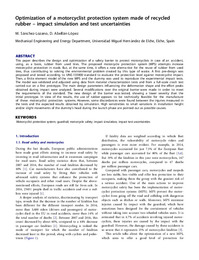Please use this identifier to cite or link to this item:
https://hdl.handle.net/11000/33429Full metadata record
| DC Field | Value | Language |
|---|---|---|
| dc.contributor.author | Sanchez Lozano, Miguel | - |
| dc.contributor.author | Abellan Lopez, David | - |
| dc.contributor.other | Departamentos de la UMH::Ingeniería Mecánica y Energía | es_ES |
| dc.date.accessioned | 2024-10-07T08:04:32Z | - |
| dc.date.available | 2024-10-07T08:04:32Z | - |
| dc.date.created | 2021-02-22 | - |
| dc.identifier.citation | International Journal of Crashworthiness , Volume 27, 2022 - Issue 4 | es_ES |
| dc.identifier.issn | 1754-2111 | - |
| dc.identifier.issn | 1358-8265 | - |
| dc.identifier.uri | https://hdl.handle.net/11000/33429 | - |
| dc.description.abstract | This paper describes the design and optimization of a safety barrier to protect motorcyclists in case of an accident, using, as a basis, rubber from used tires. The proposed motorcycle protection system (MPS) attempts increase motorcyclist protection in roads. But, at the same time, it offers a new alterna-tive for the reuse of rubber from used tires, thus contributing to solving the environmental problem created by this type of waste. A first pre-design was proposed and tested according to UNE-135900 standard to evaluate the protection level against motorcyclist impact. Then, a finite element model of the new MPS and the dummy was used to reproduce the experimental impact tests. The model was validated and adjusted using data from material characterization tests and from a full-scale crash test carried out on a first prototype. The main design parameters influencing the deformation shape and the effort peaks obtained during impact were analyzed. Several modifications over the original barrier were made in order to meet the requirements of the standard. The new design of the barrier was tested, showing a lower severity than the initial prototype. In view of the results, the use of rubber appears to be technically feasible for the manufacture of these motorcyclist protection systems. However, some discordances were found between the injuries measured in the tests and the expected results obtained by simulation. High sensitivities to small variations in installation height and/or slight movements of the dummy’s head during the launch phase are pointed out as possible causes. | es_ES |
| dc.format | application/pdf | es_ES |
| dc.format.extent | 14 | es_ES |
| dc.language.iso | eng | es_ES |
| dc.publisher | Taylor and Francis Group | es_ES |
| dc.rights | info:eu-repo/semantics/openAccess | es_ES |
| dc.rights | Attribution-NonCommercial-NoDerivatives 4.0 Internacional | * |
| dc.rights.uri | http://creativecommons.org/licenses/by-nc-nd/4.0/ | * |
| dc.subject | Motorcyclist protection system | es_ES |
| dc.subject | guardrail | es_ES |
| dc.subject | motorcycle safety | es_ES |
| dc.subject | impact simulation | es_ES |
| dc.subject | impact test uncertainties | es_ES |
| dc.subject.other | CDU::6 - Ciencias aplicadas::62 - Ingeniería. Tecnología | es_ES |
| dc.title | Optimization of a motorcyclist protection system made of recycled rubber – impact simulation and test uncertainties | es_ES |
| dc.type | info:eu-repo/semantics/article | es_ES |
| dc.relation.publisherversion | https://doi.org/10.1080/13588265.2021.1889236 | es_ES |

View/Open:
IJC_2021-PREPRINT.pdf
3,68 MB
Adobe PDF
Share:
.png)
